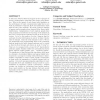Free Online Productivity Tools
i2Speak
i2Symbol
i2OCR
iTex2Img
iWeb2Print
iWeb2Shot
i2Type
iPdf2Split
iPdf2Merge
i2Bopomofo
i2Arabic
i2Style
i2Image
i2PDF
iLatex2Rtf
Sci2ools
116
click to vote
SIGMETRICS
2003
ACM
2003
ACM
Conductance and congestion in power law graphs
It has been observed that the degrees of the topologies of several communication networks follow heavy tailed statistics. What is the impact of such heavy tailed statistics on the performance of basic communication tasks that a network is presumed to support? How does performance scale with the size of the network? We study routing in families of sparse random graphs whose degrees follow heavy tailed distributions. Instantiations of such random graphs have been proposed as models for the topology of the Internet at the level of Autonomous Systems as well as at the level of routers. Let n be the number of nodes. Suppose that for each pair of nodes with degrees du and dv we have O(dudv) units of demand. Thus the total demand is O(n2 ). We argue analytically and experimentally that in the considered random graph model such demand patterns can be routed so that the flow through each link is at most O n log2 n . This is to be compared with a bound Ω n2 that holds for arbitrary graphs. S...
| Added | 05 Jul 2010 |
| Updated | 05 Jul 2010 |
| Type | Conference |
| Year | 2003 |
| Where | SIGMETRICS |
| Authors | Christos Gkantsidis, Milena Mihail, Amin Saberi |
Comments (0)

